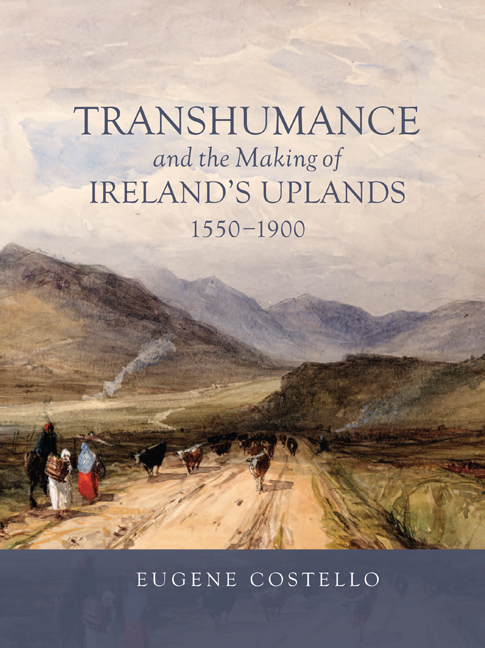Book contents
- Frontmatter
- Contents
- List of Illustrations
- Preface and Acknowledgements
- Note on Chronology
- Introduction
- Chapter 1 Seasonal Movement and Settlement in A World of Pastoralism
- Chapter 2 Imagining Movement: Past and Present Views of Transhumance in Ireland
- Chapter 3 Seasonal Sites in Context: Summer Pastures of the Carna Peninsula
- Chapter 4 Connected Places: Home and Booley in Gleann Cholm Cille Over Time
- Chapter 5 Altitude and Adaptation: Evolving Seasonal Settlement in the Galtee Mountains
- Chapter 6 Herders and Historical Forces, 1600–1900
- Conclusion
- Bibliography
- Index
Chapter 1 - Seasonal Movement and Settlement in A World of Pastoralism
Published online by Cambridge University Press: 01 October 2020
- Frontmatter
- Contents
- List of Illustrations
- Preface and Acknowledgements
- Note on Chronology
- Introduction
- Chapter 1 Seasonal Movement and Settlement in A World of Pastoralism
- Chapter 2 Imagining Movement: Past and Present Views of Transhumance in Ireland
- Chapter 3 Seasonal Sites in Context: Summer Pastures of the Carna Peninsula
- Chapter 4 Connected Places: Home and Booley in Gleann Cholm Cille Over Time
- Chapter 5 Altitude and Adaptation: Evolving Seasonal Settlement in the Galtee Mountains
- Chapter 6 Herders and Historical Forces, 1600–1900
- Conclusion
- Bibliography
- Index
Summary
MOBILE PASTORALISM AND ARCHAEOLOGY
Mobility in past societies can be approached in many different ways. The word itself may refer to the physical movement or migration of groups of people, the vertical or horizontal movement of individuals within society, the trade and exchange of their objects or the diffusion of different technologies and ways of seeing the world between regions (e.g. Beaudry et al. 2013). Where the archaeology of farming societies is concerned, regular movement across the landscape by humans and their domesticated animals has gained increasing amounts of attention in recent decades. Pastoral movements tend to be more structured and repetitive than other forms of physical human mobility (e.g. refuge, colonisation, invasion) because the herding of livestock always revolves around the availability of pasture. This introduces certain limitations on how far pastoralists may travel and when. For socio-political reasons they may not have access to certain tracts of grassland, while climate and topography may render other areas undesirable. Having said that, seasonal variations in climate and vegetation are often what encourage pastoralists to move out of one region for part of the year, in order to take advantage of better pasture in one or more areas elsewhere. Indeed, for husbandmen and women in some parts of the world these variations can be so extreme as to make movement an absolute necessity. For example, it was and is common for people and their livestock to follow rainfall in the Central Andes (Browman 1997, 24–26), the Libyan Desert (Roe 2008, 494) and the arid Egypt/ Sudan border area (Wendrich 2008, 534).
Ethnographers, anthropologists and geographers have carried out many studies of mobile pastoralists in present-day contexts, as living societies worth studying in their own right (Barth 1961; Johnson 1969; Ingold 1980; Galaty and Johnson 1990; Chang and Koster 1994; Khazanov 1994; Salzmann 2004). It is naturally more difficult to gather information on past mobility by pastoralists not simply because direct observations are now impossible but also owing to the difficulty of tracing regular movement across past landscapes. With some justification, Vere Gordon Childe has been lambasted for pronouncing over eighty years ago that ‘pastoralists are not likely to leave many vestiges by which the archaeologist could recognize their presence’ (Childe 1936, 81; see Cribb 1991, 65).
- Type
- Chapter
- Information
- Publisher: Boydell & BrewerPrint publication year: 2020



